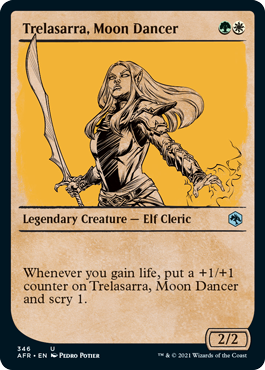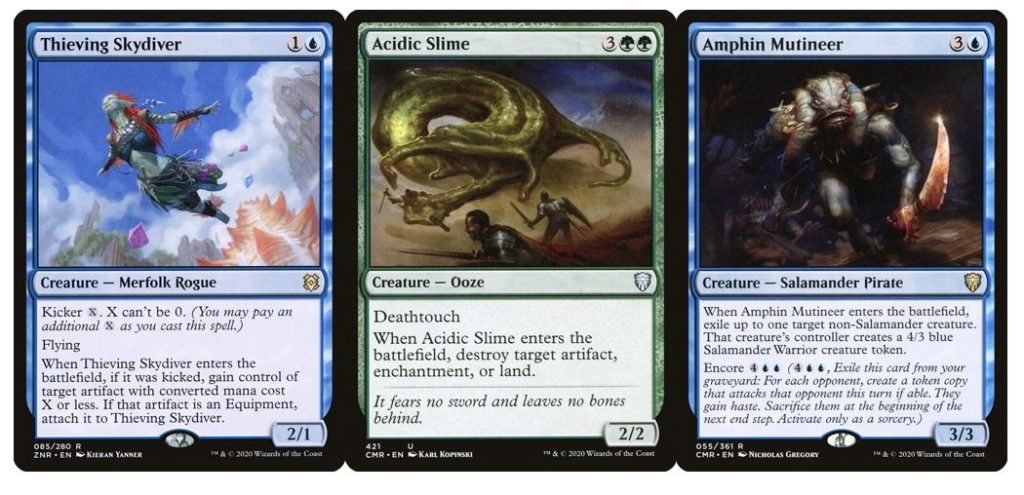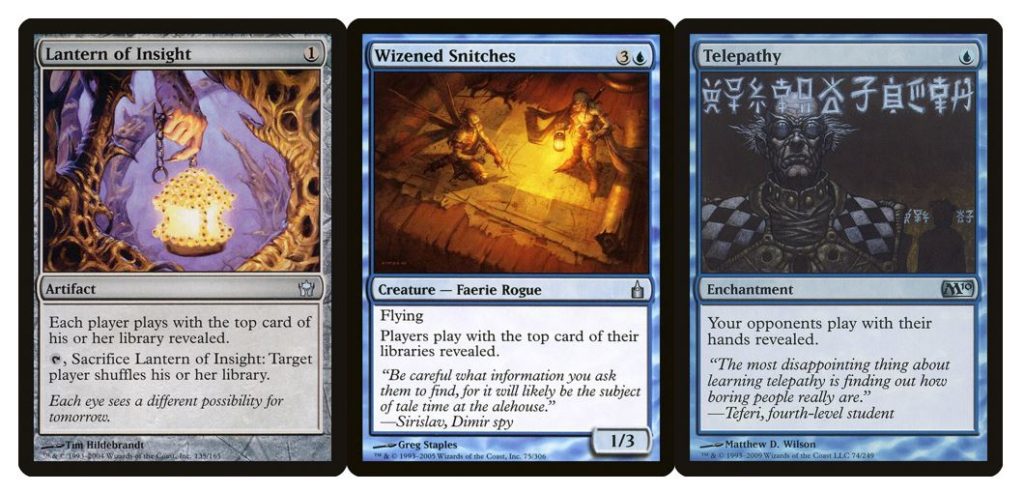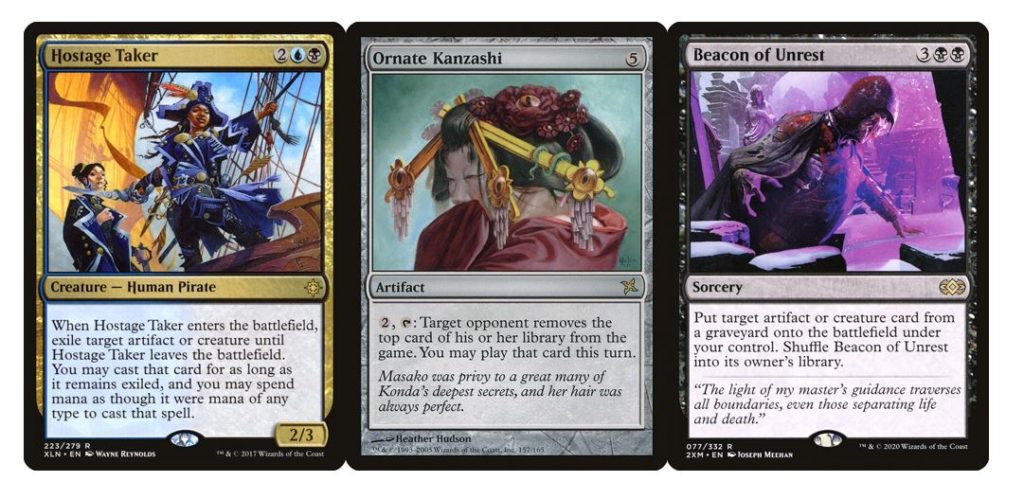With every new set come exciting new legendary creatures, and Dungeons & Dragons: Adventures in the Forgotten Realms doesn’t disappoint. The spread of different abilities and support for multiple archetypes is particularly impressive: there are some interesting twists on classic strategies like life gain, artifacts, and Dragons, as well as brand new strategies like dice rolling, dungeons, and giant space hamsters.
This week, I’ve built decks around three of the most interesting and promising new commanders from the set. I’ll go through what each deck wants to do, their key pillars, and how they win the game. Each decklist is around the $100-120 mark, with no individual cards costing more than a few dollars. These can be taken as is, or used as a base from which to build your own deck. Let’s venture into the first one, which is a reimagining of an age-old archetype favored by newbies: life gain!
Trelasarra, Moon Dancer: Life Gain/Aggro

Life gain is a strategy that’s always been associated with newer players, ever since Healing Salve’s printing all the way back in Alpha. It’s never been viewed as a particularly strong strategy; gaining life doesn’t usually win the game by itself — it only prevents you from losing. Still, it’s a popular strategy nonetheless, and it’s been getting increased support lately.
You could be forgiven for mistaking Trelasarra, Moon Dancer for Ajani’s Pridemate, as that’s essentially what she is! Having access to such a potent growth effect in the command zone changes how life gain should be viewed in Commander. Trelasarra can weaponize life gain extremely effectively, and could shine as a Voltron commander.

Soul Warden is a classic life gain card, rewarding you for every creature you play. This translates to Trelasarra growing whenever a creature enters the battlefield, which can get out of hand quickly when there are four players! Similarly, Suture Priest rewards you for playing more creatures, but the difference here is it will punish opponents for doing the same thing. It’s also a great failsafe against infinite creature combos like Kiki-Jiki and Zealous Conscripts. Authority of the Consuls may only work for opposing creatures, but it prevents haste creatures from attacking right away, or commanders like Krenko, Mob Boss from getting suited up with Swiftfoot Boots for an immediate activation.

Trelasarra gains +1/+1 counters with all this life gain, so that’s something that could be enhanced to give the deck more options for additional value. Conclave Mentor will stack up additional counters on any of your creatures, which can turn protection spells like Unbreakable Formation into massive boosts to your power output. They also gain life for you when they die, which is an extra synergistic bonus. Light of Promise effectively doubles Trelasarra’s growth effect, or can be put onto another creature to build a secondary threat. All of these effects can be used to either lean even heavier into Trelasarra, or spread power out among your Soul Sisters and develop a small but dangerous army!

There are even more ways to take advantage of all your instances of life gain. Cosmos Elixir will almost always draw you a card, and will grow your commander otherwise. Trudge Garden is to life gain as Rampaging Baloths is to landfall: it gives you additional power just for playing the game, and it can get out of hand quickly if you really lean into it. Crested Sunmare is a little bit pricey, but it’s so easy for it to generate 20 power per turn cycle in this deck that it’s worth the consideration.

Life gain strategies that rely on outlasting their opponents are a thing of the past; now, there are a number of ways to close out the game quickly, even when battlefields are clogged up. Fortifying Draught is an extremely vicious way to take out an opponent in one shot; it can easily become a +10/+10 boost for one mana. The same applies to Blossoming Bogbeast: this will become your Craterhoof Behemoth with very little effort, turning all of your smaller creatures into lethal threats. Finally, Felidar Sovereign is a staple of life gain decks, offering an easily attainable alternate win condition for when combat just won’t cut it.
Ajani’s Pridemate has always been beloved by many for its ability to grow out of control and really reward life gain strategies. Now that it’s in the command zone in the form of Trelasarra, Moon Dancer, there’s never been a better time to take out a second life pad and a spare pen — you’re going to need it!
Volo, Guide to Monsters: Bestiary/Pokedex

Volo, Guide to Monsters is a well-known character from the Forgotten Realms, famous for his — well, Guide to Monsters. Any creature you’ve ever seen or heard of, he’s got it on file. A deck centered around such a knowledgeable individual would surely want to showcase this, which is why this deck is full of entirely unique creatures! To make the most of his ability, there needs to be minimal overlap in the creature types in the deck; as he’s a Human Wizard, there should be as few Humans and Wizards as possible, as they can’t be copied by his ability.

Starting off the list of monsters are some strong value creatures. Hornet Queen is a board-in-a-box, and getting a copy of them from Volo amasses an immediate army. Toski is incredible for keeping the cards flowing, but unfortunately doesn’t copy well, as it’s legendary. Thankfully, Spark Double is your Illusion of choice; you can duplicate Toski with it, or even make a copy of Volo himself! With his ability, you’ll actually make two copies of Spark Double, giving you even more value!

There are myriad creatures in blue and green that can function as effective removal. With Thieving Skydiver, you can steal anything from Mana Vault to Helm of the Host, turning that problem into someone else’s instead! Acidic Slime needs no introduction; it’s one of the most popular green removal creatures in the format, and for good reason. Amphin Mutineer is a relative newcomer, and it’s one I gushed about in my article about 5 Blue Cards You Should Play in Commander. It’s a decent effect on the front half that’s made twice as good with your commander here, and the encore ability is great to help mop up some tricky creatures later in the game.

As you’re essentially playing with a bestiary, it’s important to know what you need at any given time, and have a way to find it. Neoform replaces one of your current creatures with whatever toolbox piece you may need, and with the extra creatures that Volo makes, you’ll have plenty of options. Shared Summons is particularly impressive, given that it tutors for any two creatures in your deck. You can use both of these to fetch the right creature for the job, or just to accrue some extra value. Speaking of which, Double Major functions as a single use of Volo’s ability, with the exception that you can effectively copy legendary creatures, too. So you can have a second Toski, after all!

When it comes to ending the game, there are a number of ways you can approach it. My favorite choice is the new Ivy Lane Denizen/Scurry Oak combo, which generates infinite creatures and makes an arbitrarily large Treefolk. If I were Volo, I’d be proud to take over with an army of Squirrels, a massive tree, and a street vendor! If you’re looking for a more conventional win condition, End-Raze Forerunners is there to get the job done; they’ll have no problems turning your smorgasbord of value creatures into a lethal force.
Even though I’ve provided a full list for Volo, Guide to Monsters, I highly recommend brewing this one up yourself. It felt like one big puzzle: trying to fit all of the best creatures into the deck while minimizing overlap in creature types was extremely enjoyable. It’s definitely one of the more satisfying decks to build, and one of the most value-packed that I’ve experienced!
Xanathar, Guild Kingpin: Politics/Steal Your Deck

As soon as Xanathar, Guild Kingpin was previewed, players immediately compared it to Sen Triplets. The two cards have some things in common, though as we look deeper, you’ll find that there is potential for Xanathar to become one of the most interesting political commanders.
Politics decks tend to be quite popular with the rest of the table: they lean heavily into the spirit of the format, and are usually quite dynamic and adaptable in terms of power level. Forging contracts is the bread and butter of playing the politician, and Xanathar will make sure you get the most out of each of them.

Every good crime boss has eyes lurking in the shadows, and Xanathar is no different. Lantern of Insight will tell you what each person has on the top of their deck, allowing you to make more informed choices when you take over a player during your turn. Snitches might get stitches, but not when they’re reporting to the head of the organization. Wizened Snitches gives you additional redundancy beside Lantern of Insight, making it easier for you to keep informed. Telepathy would be a great power to have as the head of a syndicate, so naturally, Xanathar makes excellent use of the enchantment. For just one mana, your opponents can no longer keep any information from you; this not only gives you an immediate advantage in negotiations, but prevents opponents from trying anything funny.

Once you know what’s in their hands and what’s coming up, you can manipulate this information to benefit you most. Codex Shredder can skim a card off the top, in case you don’t see anything worth taking with Xanathar. You can also use it to control people’s draws, similar to Lantern Control in Modern. Portent looks like a slow Ponder, except it can target opponents, too; you can use it to stack draws to your advantage or put something nice on top for your opponent, provided they do something for you in return. Memory Lapse is the best suited counterspell for Xanathar. See someone casting a spell you like the look of? Memory Lapse not only stops them from having their fun, but you can now cast that spell on your turn when you take over their deck!

Every crime boss worth their salt has backups — either to take over if things go sour or to help push harder toward victory. Hostage Taker will convert even the strongest creature in the ranks of the opposition without so much as a sound. Xanathar may look strange wearing an Ornate Kanzashi, but it functions as a serviceable backup for the Beholder if he’s been removed too many times. Beacon of Unrest is a five-mana five finger discount, letting you grab whatever takes your fancy from opposing graveyards. These additional measures work well as individual schemes, but can also compliment your commander in planning elaborate heists.

The main way to win the game is often to find something powerful in your opponents’ decks, but there are escape plans in case you don’t hit the jackpot. With the amount of milling you’ll be doing with Codex Shredder, Ghoulcaller’s Bell, etc., Syr Konrad the Grim becomes a viable win condition. Syr Konrad also works brilliantly with Mindcrank, which is here with Duskmantle Guildmage for an infinite mill combo. It’s an old combo, but both pieces work well by themselves in this deck, so it’s another neat win condition that doesn’t take up any dedicated space.
Xanathar is an iconic character from D&D that deserves to have an equally memorable deck. With a brew like this, you’ll be sure to build a name for yourself as someone that drives a hard bargain at the table, but always guarantees a good time!
***
These are just three of the commanders available in Dungeons & Dragons: Adventures in the Forgotten Realms; there are 30 possible legendary creatures to build around in the set, so be sure to take a look for yourself to see what takes your fancy. I hope these decks have helped to spark some ideas for you, or provide you with a solid starting point for your own versions.
What’s your favorite commander from the set? Have you built any sweet decks you’d like to show off? Let me know over on Twitter — I’d love to see what you come up with!

Scott is an Irish content creator and the Head of Budget Magic for the Izzet League. He focuses on affordable decks in Pioneer, Modern, and Pauper, particularly ones that stray from the mainstream. When he’s not writing about his favorite decks, he can be found talking incessantly about them on Twitter and on The Budget Magic Cast.

